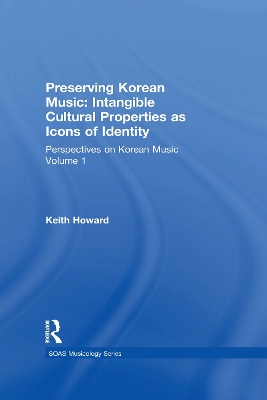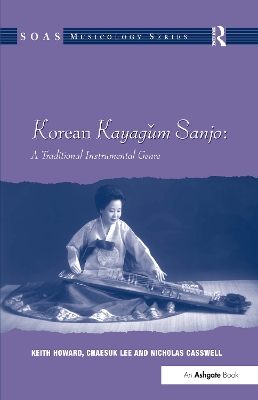SOAS Studies in Music
3 total works
SamulNori is a percussion quartet which has given rise to a genre, of the same name, that is arguably Korea’s most successful ’traditional’ music of recent times. Today, there are dozens of amateur and professional samulnori groups. There is a canon of samulnori pieces, closely associated with the first founding quartet but played by all, and many creative evolutions on the basic themes, made by the rapidly growing number of virtuosic percussionists. And the genre is the focus of an abundance of workshops, festivals and contests. Samulnori is taught in primary and middle schools; it is part of Korea’s national education curriculum. It has dedicated institutes, and there are a number of workbooks devoted to helping wannabe ’samulnorians’. It is a familiar part of Korean performance culture, at home and abroad, in concerts but also in films and theatre productions. SamulNori uses four instruments: kkwaenggwari and ching small and large gongs, and changgo and puk drums. These are the instruments of local percussion bands and itinerant troupes that trace back many centuries, but samulnori is a recent development of these older traditions: it was first performed in February 1978. This volume explores this vibrant percussion genre, charting its origins and development, the formation of the canon of pieces, teaching and learning strategies, new evolutions and current questions relating to maintaining, developing, and sustaining samulnori in the future.
As Korea has developed and modernized, music has come to play a central role as a symbol of national identity. Nationalism has been stage managed by scholars, journalists and, from the beginning of the 1960s, by the state, as music genres have been documented, preserved and promoted as 'Intangible Cultural Properties'. Practitioners have been appointed 'holders' or, in everyday speech, 'Human Cultural Properties', to maintain, perform and teach exemplary versions of tradition. Over the last few years, the Korean preservation system has become a model for UNESCO's 'Living Human Treasures' and 'Masterpieces of the Oral and Intangible Heritage of Mankind'. In this volume, Keith Howard provides the first comprehensive analysis in English of the system. He documents court music and dance, Confucian and shaman ritual music, folksongs, the professional folk-art genres of p'ansori ('epic storytelling through song') and sanjo ('scattered melodies'), and more, as well as instrument making, food preparation and liquor distilling - a good performance, after all, requires wine to flow. The extensive documentation reflects considerable fieldwork, discussion and questioning carried out over a 25-year period, and blends the voices of scholars, government officials, performers, craftsmen and the general public. By interrogating both contemporary and historical data, Howard negotiates the debates and critiques that surround this remarkable attempt to protect local and national music and other performance arts and crafts. An accompanying downloadable resource illustrates many of the music genres considered, featuring many master musicians including some who have now died. The preservation of music and other performance arts and crafts is part of the contemporary zeitgeist, yet occupies contested territory. This is particularly true when the concept of 'tradition' is invoked. Within Korea, the recognition of the fragility of indigenous music inherited from earlier times is balanced by an awareness of the need to maintain identity as lifestyles change in response to modernization and globalization. Howard argues that Korea, and the world, is a better place when the richness of indigenous music is preserved and promoted.
Korean Kayagum Sanjo: A Traditional Instrumental Genre
by Keith Howard and Chaesuk Lee
Published 28 March 2008
The Korean genre of sanjo is today one of the most popular genres of traditional music, taught in schools and universities within Korea, and a staple of national and international performance tours. Sanjo comprises a set of related pieces for solo melodic instrument and drum. A number of 'schools' (ryu) are recognized, each based on the performance style of a master musician, usually a musician from an earlier generation. Sanjo was first devised for the kayagum 12-stringed plucked long zither and is now played on all major Korean instruments. The solo melodic instrument is accompanied by a drum. The two Sino-Korean characters that comprise the term 'sanjo' can be translated as 'scattered melodies', but such a translation hardly does justice to the complexity of sanjo: each piece, played in entirety, can last for an hour, although in concerts players will often choose segments from this long piece to fit a specified time frame. Amongst contemporary performers, Chaesuk Lee has done much to develop our understanding of sanjo. In her career, she has combined scholarly research with performing. One of the first students of the Seoul National University programme in kugak, Korean traditional music, the first female professor of kugak in Korea, and today the only female music scholar in the Korean National Academy of Arts, she worked with the most senior master musicians of kayagum sanjo, chief amongst them Kim Chukp'a (1911-1989). Kim was the grandaughter of the putative founder of sanjo, Kim Ch'angjo. Kim Chukp'a had been a celebrated performer in her youth, but she retired as a professional musician in the early 1930s when she married her first husband. This volume explores, records, notates and documents the Kim Chukp'a school of kayagum sanjo. It is the result of collaboration between Chaesuk Lee, the ethnomusicologist Keith Howard and the composer and musicologist Nicholas Casswell. Two audio CDs accompany the book, one featuring Lee playing Kim's complete sanjo, and the second, a 'bonus' CD of a second sanjo for the six-stringed zither, komun'go, played by Kim Sunok.


